(完整版)新目标英语九年级教学案例
- 格式:doc
- 大小:24.51 KB
- 文档页数:2
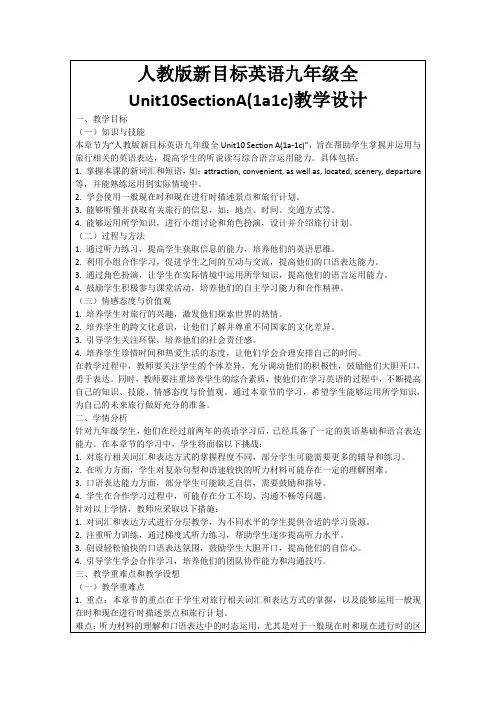
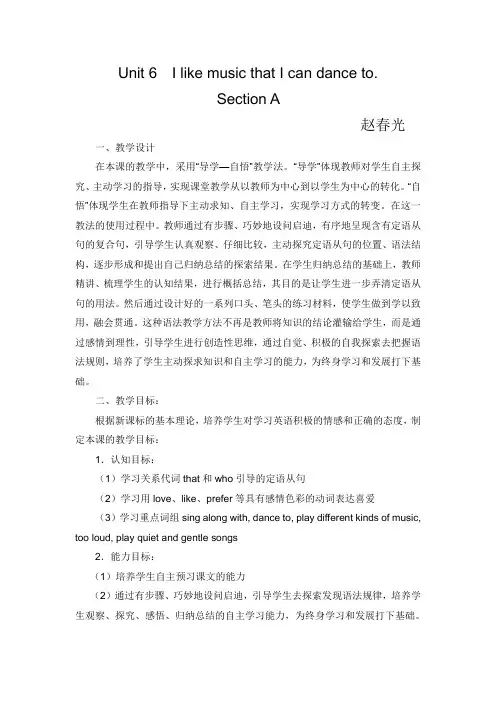
Unit 6 I like music that I can dance to.Section A赵春光一、教学设计在本课的教学中,采用“导学—自悟”教学法。
“导学”体现教师对学生自主探究、主动学习的指导,实现课堂教学从以教师为中心到以学生为中心的转化。
“自悟”体现学生在教师指导下主动求知、自主学习,实现学习方式的转变。
在这一教法的使用过程中。
教师通过有步骤、巧妙地设问启迪,有序地呈现含有定语从句的复合句,引导学生认真观察、仔细比较,主动探究定语从句的位置、语法结构,逐步形成和提出自己归纳总结的探索结果。
在学生归纳总结的基础上,教师精讲、梳理学生的认知结果,进行概括总结,其目的是让学生进一步弄清定语从句的用法。
然后通过设计好的一系列口头、笔头的练习材料,使学生做到学以致用,融会贯通。
这种语法教学方法不再是教师将知识的结论灌输给学生,而是通过感情到理性,引导学生进行创造性思维,通过自觉、积极的自我探索去把握语法规则,培养了学生主动探求知识和自主学习的能力,为终身学习和发展打下基础。
二、教学目标:根据新课标的基本理论,培养学生对学习英语积极的情感和正确的态度,制定本课的教学目标:1.认知目标:(1)学习关系代词that和who引导的定语从句(2)学习用love、like、prefer等具有感情色彩的动词表达喜爱(3)学习重点词组sing along with, dance to, play different kinds of music, too loud, play quiet and gentle songs2.能力目标:(1)培养学生自主预习课文的能力(2)通过有步骤、巧妙地设问启迪,引导学生去探索发现语法规律,培养学生观察、探究、感悟、归纳总结的自主学习能力,为终身学习和发展打下基础。
3.情感目标:通过小组合作学习和竞赛形式,调动学生主体参与意识,培养学生的合作精神和团队意识,让学生体验成功,培养自信心。
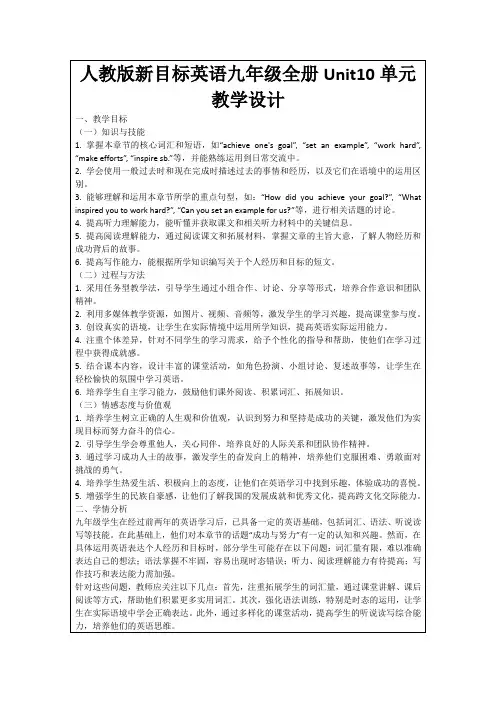
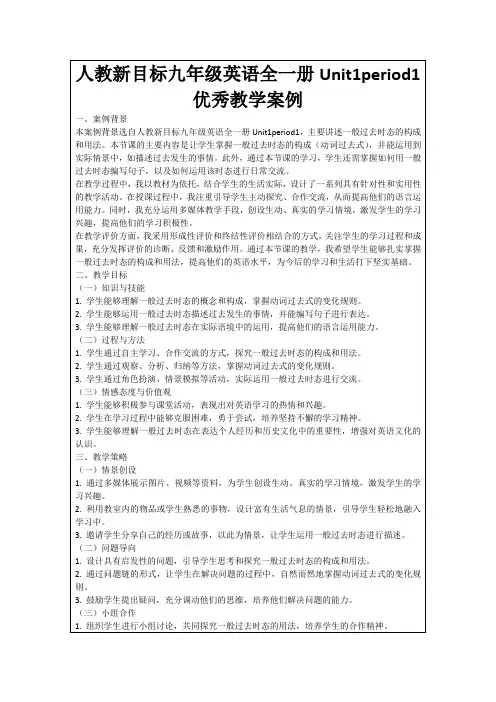
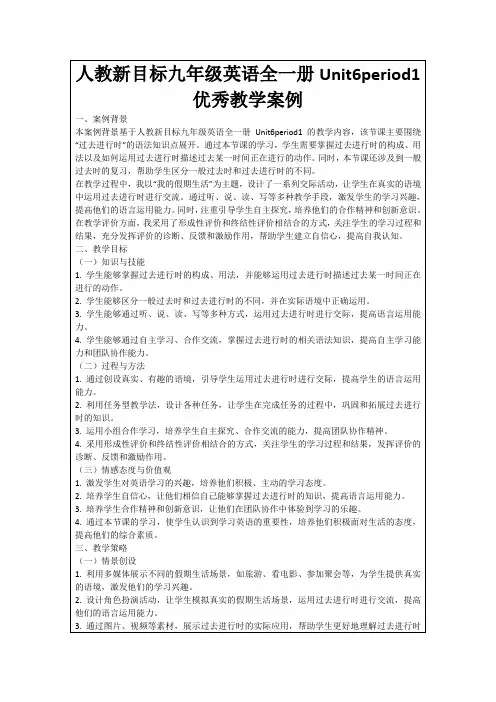
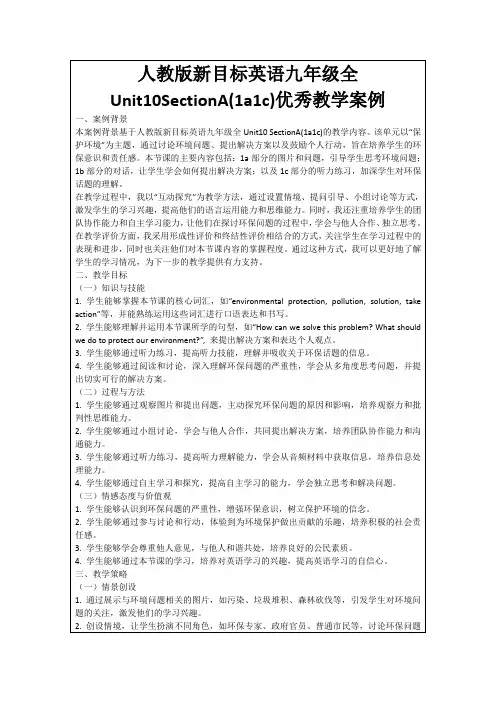
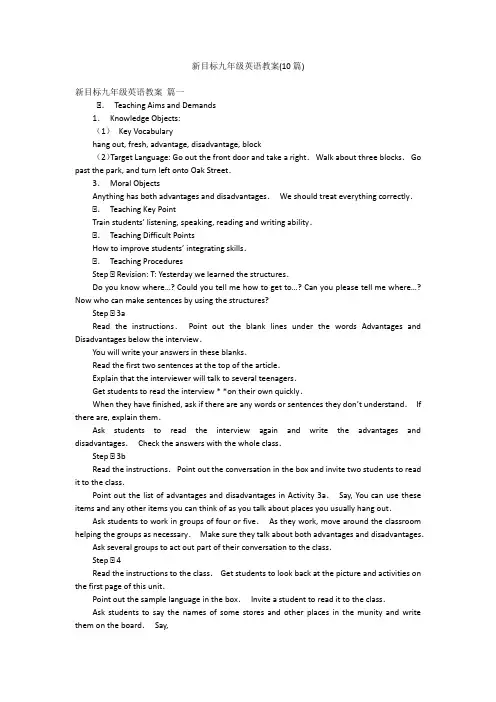
新目标九年级英语教案(10篇)新目标九年级英语教案篇一Ⅰ.Teaching Aims and Demands1.Knowledge Objects:(1)Key Vocabularyhang out, fresh, advantage, disadvantage, block(2)Target Language: Go out the front door and take a right.Walk about three blocks.Go past the park, and turn left onto Oak Street.3.Moral ObjectsAnything has both advantages and disadvantages.We should treat everything correctly.Ⅰ.Teaching Key PointTrain students’ listening, speaking, reading and writing ability.Ⅰ.Teaching Difficult PointsHow to improve students’ integrating skills.Ⅰ.Teaching ProceduresStep Ⅰ Revision: T: Yesterday we learned the structures.Do you know where…? Could you tell me how to get to…? Can you please tell me where…? Now who can make sentences by using the structures?Step Ⅰ 3aRead the instructions.Point out the blank lines under the words Advantages and Disadvantages below the interview.You will write your answers in these blanks.Read the first two sentences at the top of the article.Explain that the interviewer will talk to several teenagers.Get students to read the interview * *on their own quickly.When they have finished, ask if there are any words or sentences they don’t understand.If there are, explain them.Ask students to read the interview again and write the advantages and disadvantages.Check the answers with the whole class.Step Ⅰ 3bRead the instructions.Point out the conversation in the box and invite two students to read it to the class.Point out the list of advantages and disadvantages in Activity 3a.Say, You can use these items and any other items you can think of as you talk about places you usually hang out.Ask students to work in groups of four or five.As they work, move around the classroom helping the groups as necessary.Make sure they talk about both advantages and disadvantages.Ask several groups to act out part of their conversation to the class.Step Ⅰ 4Read the instructions to the class.Get students to look back at the picture and activities on the first page of this unit.Point out the sample language in the box.Invite a student to read it to the class.Ask students to say the names of some stores and other places in the munity and write them on the board.Say,Each group can choose three of these places to write about, or you can choose another place you know ofWrite careful directions from the school to each place, but do not say the name of the place.You can use the words this place instead.In order to help students work, draw a simple map showing the school and several nearby streets.When the groups are ready, they read their directions to the class and the other students guess the name of the place they are talking about.Step Ⅰ Homework1.Ask students to choose two places in the munity and write careful directions from the school to each place.2.Finish off the exercises on pages 46~47 of the workbook.新目标九年级英语教案篇二Paragraph 1When you visit a foreign country, it is important to know how to ask for help politely (adv. 礼貌地)….Paragraph 2Good speakers change the way they speak in different situations. …Paragraph 3Usually polite questions are longer. They include expressions such as “Could you please …?” or “May I ask …?”Paragraph 4However, it is important to learn how to use the right language in different situations. …2) Read the article again and answer the questions.Read paragraph 1 and answer the question.What else do we need to learn besides asking a question correctly when you ask for help?We need to learn how to be polite when we ask for help.Read paragraph 2 and answer the question.What do we need to think about when you talk to different people?We need to think about whom we speak to or how well we know them.Read paragraph 3 and answer the question.What can lead in to a request with a stranger on the street?“Excuse me, I wonder if you can help me” or “I’m sorry to trouble you, but …” before asking for help.2c Find all the direct questions and polite requests from the passage.Direct questions Polite requests1. 1. Where are the restrooms?2. When is the school trip?3. Peter, tell me your e-mail address.4. Where’s the post office?1. Could you tell me where the restrooms are?2. Excuse me, Mr. West.Do you know whenthe school trip is?3. Peter, could youplease tell meyour e-mail address?4. Pardon me, could you please tell me where to park my car?2d Read the requests below. In the second column, write A if you would say it to someone you know and B if you would say it to a stranger. In the last column, write where you think these people are.Request Person Place1. Will you pass the salt? A home2. Do you know where I can change some money, please? B street3. Could you tell me what just happened? A/B any public place/home4. Can you please tell me where the nearest station is? B street5. Excuse me, do you know what time it begins, please? B movie theater6. Let me know when you’re ready, OK? A home7. Could you possibly tell me the way to the village school? B streetStep 9 Language points1. Both are correct, but the first one sounds less polite.less + 形容词或副词,构成降级比较形式,相当于中文“不那么;稍许不……”之意。
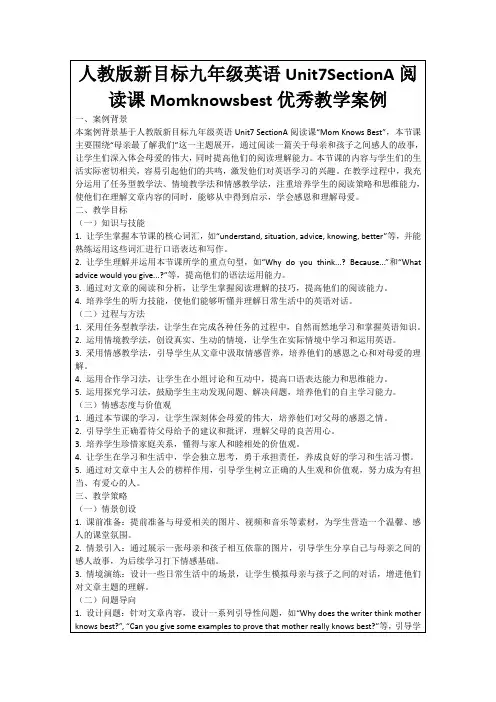
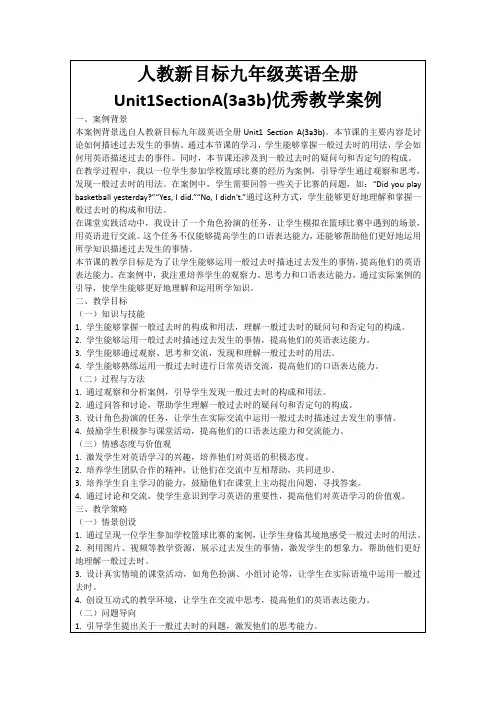
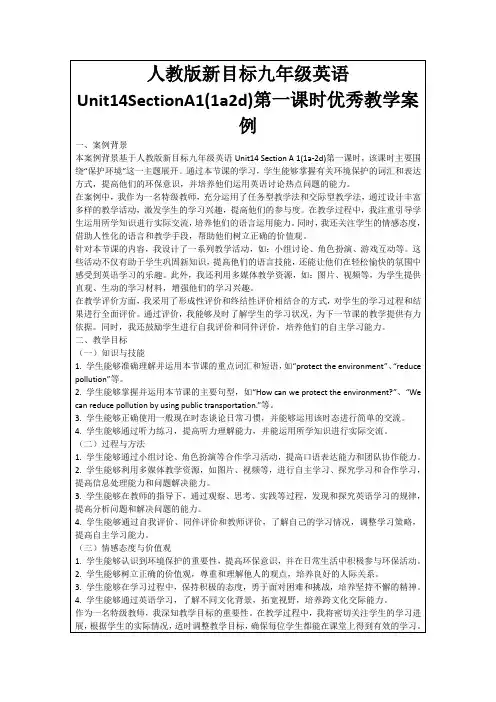
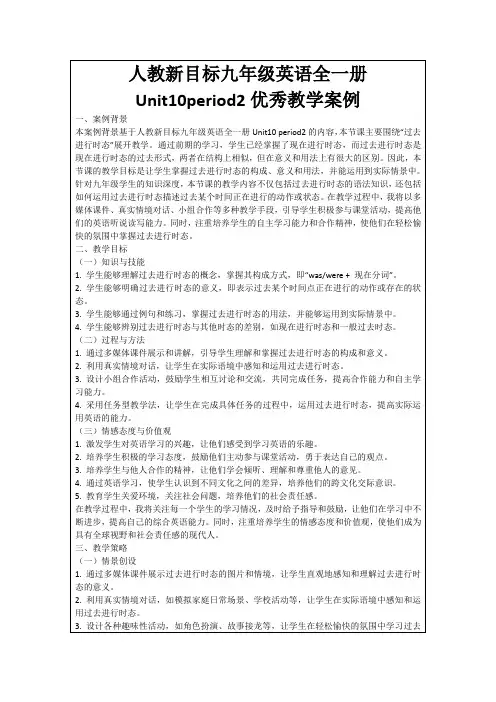
Unit 6 I like music that I can dance to.
Section A
赵春光
一、教学设计
在本课的教学中,采用“导学—自悟”教学法。
“导学”体现教师对学生自主探究、主动学习的指导,实现课堂教学从以教师为中心到以学生为中心的转化。
“自悟”体现学生在教师指导下主动求知、自主学习,实现学习方式的转变。
在这一教法的使用过程中。
教师通过有步骤、巧妙地设问启迪,有序地呈现含有定语从句的复合句,引导学生认真观察、仔细比较,主动探究定语从句的位置、语法结构,逐步形成和提出自己归纳总结的探索结果。
在学生归纳总结的基础上,教师精讲、梳理学生的认知结果,进行概括总结,其目的是让学生进一步弄清定语从句的用法。
然后通过设计好的一系列口头、笔头的练习材料,使学生做到学以致用,融会贯通。
这种语法教学方法不再是教师将知识的结论灌输给学生,而是通过感情到理性,引导学生进行创造性思维,通过自觉、积极的自我探索去把握语法规则,培养了学生主动探求知识和自主学习的能力,为终身学习和发展打下基础。
二、教学目标:
根据新课标的基本理论,培养学生对学习英语积极的情感和正确的态度,制定本课的教学目标:
1.认知目标:
(1)学习关系代词that和who引导的定语从句
(2)学习用love、like、prefer等具有感情色彩的动词表达喜爱
(3)学习重点词组sing along with, dance to, play different kinds of music, too loud, play quiet and gentle songs
2.能力目标:
(1)培养学生自主预习课文的能力
(2)通过有步骤、巧妙地设问启迪,引导学生去探索发现语法规律,培养学生观察、探究、感悟、归纳总结的自主学习能力,为终身学习和发展打下基础。
3.情感目标:通过小组合作学习和竞赛形式,调动学生主体参与意识,培养学生的合作精神和团队意识,让学生体验成功,培养自信心。
三、教学流程:
Step 1 Organization of class 设计意图
Step2 Words competition 复习单词、为课文教学扫除障碍
Step 3 Presentation
Present “that” classes by discussing the following question with the class 引导学生观察定语从句结构,发现语法规律
(1)What kind of food do you like?
(2)What kind of music do you like? 帮助学生熟悉定语从句用法
Step 4 Listening practice
Listen and finish the chart in 1b 培养学生听力
Step 5 Pair work
Tack about ten music yon like
通过俩俩对话,熟练掌握that引导的定语从句
Step6 Presentation
Present “who” classes by discussing
呈现who引导的定语从句
The question “what kind of teachers do you prefer?”
引导学生观察总结语法规律
Step 7 Listen and circle “T” or “F” in 2a 训练听力,进一步熟悉定语从句用法。
Step 8 Make a survey
Step9 Written exercises 用笔头练习,巩固本节所学内容
Step 10 Summary 培养归纳总结能力
Step 11 Homework
强调复习和预习的重要性,为学生终身发展奠定基础。
反思:本节的语法(定语从句)是难点,特别是翻译上,所以虽然学生对目标语言比较熟练,但还需通过练习做到学以致用。